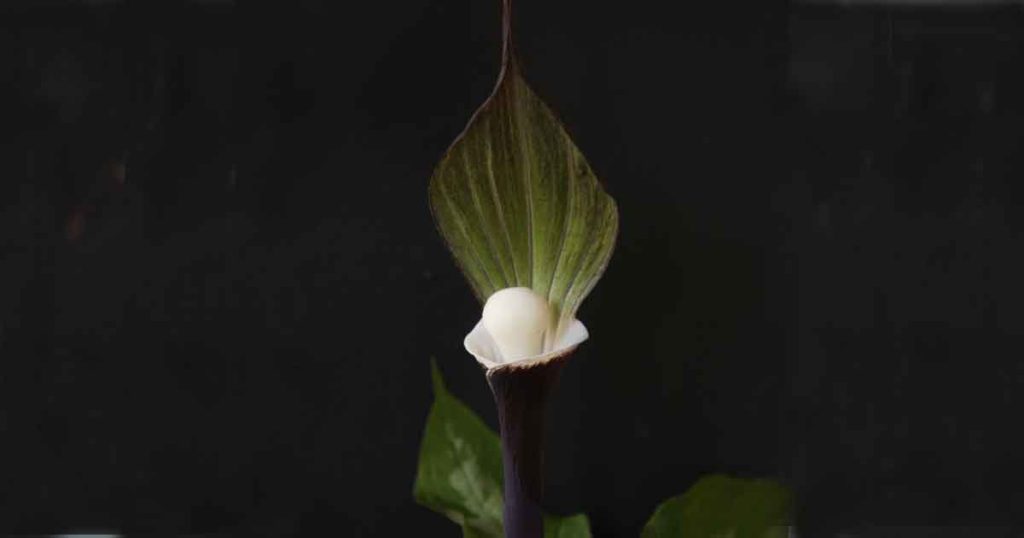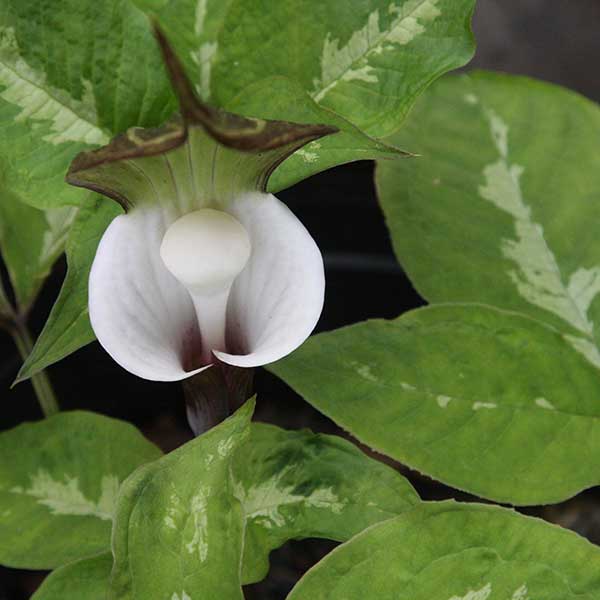Japanese Cobra Lily

If you are looking for bold dramatic flowers then Arisaema sikokianum will be the one for you.
One of the many interesting Arisaema species, this particular plant is much sought after for its dramatic hooded flower. It grows naturally in moist shaded woodland areas in Japan, in particular on Shikoku island.
The contrast between the dark hood and the snowy, pure white spadix making a dramatic picture in any garden. The light green marking are an added accent.
A.sikokianum is more dramatic when in flower than most other species, firstly because of the flower itself, secondly as it holds the flower above the foliage so it is in full visibility. A. ringens and candidissimum have amazing flowers as well, however hold them beneath the foliage, the flowers last for weeks, the foliage for months so grow this one in a clump in the garden for great effect.
Sometimes known as the Japanese Jack in the Pulpit or Japanese cobra lily. With its dark flower and its contrasting white spadix it grows to nearly 30 inches.
Long lasting foliage is another added attraction with this outstanding plant. A silver leaf form or ‘Silver Centre’ form is also available, the leaves have a splash of silver in the centre.

Arisaema sikokianum Care
This is an easy plant to grow in a humus rich well drained soil.
- Grow in a woodland setting, dappled shade.
- A humus rich soil.
- Moist Soil
- Never wet and soggy
- Keep moist even when the plant is in dormancy.
- Mulch with compost and aged cow manure after flowering.
- Wait until the flower stem dies back before removing.
- Allow foliage to die back naturally.
- Leave the bulbs undisturbed for 3 – 4 years before dividing.
- Use a little liquid fertiliser in early spring.
Arisaema sikokianum will grow well in a part shaded woodland position. This arisaema may also be grown in a container or large garden pot.
Arisaema sikokianum Propagation
Arisaemas have a remarkable ability to change sex, most start off as males and as they settle in and begin to gain energy they become female. This is when the flowers are at their best and seed will be produced.
Under poor growing conditions they can revert to or stay as males. If seeds are set, then collect them, as A. sikokianum does not naturally multiply by division.
Collecting and Preparing The Seed
- Seed heads can contain up to 1000 seeds and can be collected in late autumn/fall for propagation.
- The seeds are collected when they have ripened (turned red and a little soft)
- They are then cleaned to remove the pulp around them which inhibits germination.
- Sow the seeds in late winter to early spring.
Sowing The Seed
- Soak the seeds for 2 days before planting changing the water twice a day,
- Use a free draining potting mix, perlite and vermiculite in equal quantities.
- Use larger deep pots 10cm or so.
- Fill the pots with with the soil mix and tamp down.
- Water the mix
- Sow the seeds the surface and cover with 2 cm of the soil mix. You can plant a number of seeds in the one pot, just space them 2 cm apart.
- Mist spray to water them in.
- The pots are best kept in a clear covered tray to lessen water loss.
- You can also use plastic zip lock bags.
- Check every few day to ensure the soil is still moist.
- Seeds should germinate within 2 months.
- Let them grow through the first season and go into dormancy.
Growing On and Transplanting
- Grow them on through the second season and allow to go dormant again. – This is why we use larger pots.
- In the second growing season use a liquid seaweed /fish fertiliser every 3 weeks during active growth.
- Now it’s time to pot up the individual tubers.
- It will take 4 – 5 years to a good sized flowering plant from seed, so be patient.
Other Species
Summary Information
- Botanical Name : Arisaema sikokianum
- Common Name : Chinese/Japanese cobra Lily or Jack in the Pulpit
- Family Name : Aracaeae
- USDA Zone : 4 – 8
- Height : 30 inches (.75 metre)
- Spread : 20 inches (.5 metre)
- Flower : Unusual snowy white cup.
- Flowering Time : Spring.
- Foliage : Mid green.
- Growth Rate : Medium to Fast
- Soil : Humus rich, moist and well drained
- Light : Medium to Light shade.
- Humidity : Medium
- Container Growing : Yes
- Frost Tolerance : Light frosts only
- Drought Tolerant : No

